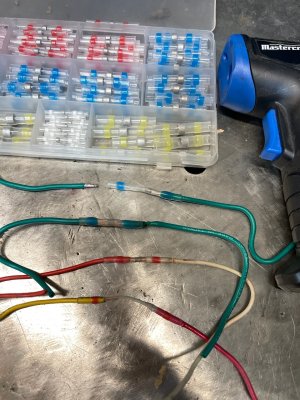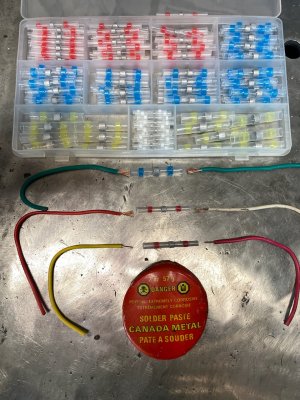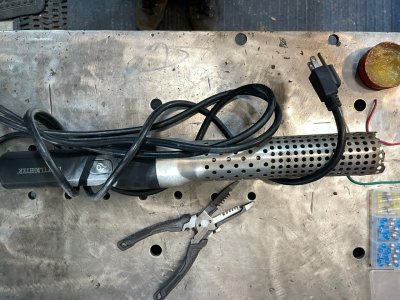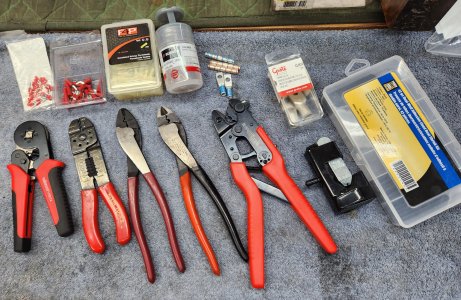Re: test of heat shrink connectors with solder:
I’ve received and tried the (inexpensive from Amazon) electrical wire connectors that shrink + on have adhesive +solder all in one.
Here’s the good, the bad, and the ugly of my test -
I connected: 14 gauge strand wire both with and without solder flux; 20 gauge strand wire; and 20 gauge solid wire. I used a heat gun designed to start charcoal as a heat source- likely a bit too agressive but it’s what i have and it’s less aggressive & more controllable than an open flame.
Note 1- It was hard to melt the solder without damaging the adjacent wire insulation.
Note 2 - maybe a less aggressive heat source would have been better, i monitored the temperature and tried to keep it below 200 F.
Results:
The good- the 14 gauge with the flux looks great and couldn’t be pulled apart. Also good was the connection with the 20 gauage wire.
The bad - the other 14 gauge connection without flux pulled apart easily (i think the failure had nothing to do with the flux)
The ugly - the 20 gauge solid wire pulled apart easily.
Bottom line:
- Maybe more practice and a better heat source would have given better results;
- commercial grade connectors likely better than sourcing from Amazon
- could have twisted the wires but i followed the instructions;
- didn’t think it is a worthwhile time saver considering how seldom I do this (vs solder the connection and then using a good heat shrink that has adhesive);
- failure rate was too high;
- this procedure is too sensitive;
- glad I didn’t spend more than $20 bucks to lean these connectors are not for me!!!
I’ve received and tried the (inexpensive from Amazon) electrical wire connectors that shrink + on have adhesive +solder all in one.
Here’s the good, the bad, and the ugly of my test -
I connected: 14 gauge strand wire both with and without solder flux; 20 gauge strand wire; and 20 gauge solid wire. I used a heat gun designed to start charcoal as a heat source- likely a bit too agressive but it’s what i have and it’s less aggressive & more controllable than an open flame.
Note 1- It was hard to melt the solder without damaging the adjacent wire insulation.
Note 2 - maybe a less aggressive heat source would have been better, i monitored the temperature and tried to keep it below 200 F.
Results:
The good- the 14 gauge with the flux looks great and couldn’t be pulled apart. Also good was the connection with the 20 gauage wire.
The bad - the other 14 gauge connection without flux pulled apart easily (i think the failure had nothing to do with the flux)
The ugly - the 20 gauge solid wire pulled apart easily.
Bottom line:
- Maybe more practice and a better heat source would have given better results;
- commercial grade connectors likely better than sourcing from Amazon
- could have twisted the wires but i followed the instructions;
- didn’t think it is a worthwhile time saver considering how seldom I do this (vs solder the connection and then using a good heat shrink that has adhesive);
- failure rate was too high;
- this procedure is too sensitive;
- glad I didn’t spend more than $20 bucks to lean these connectors are not for me!!!




